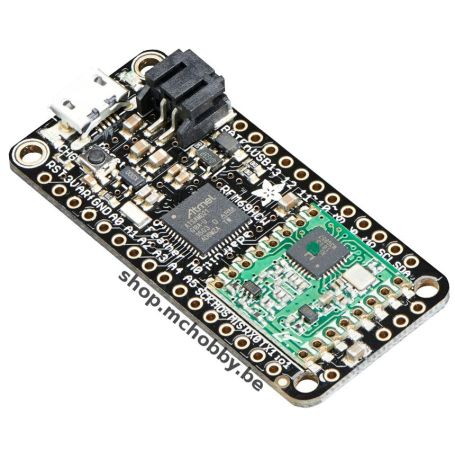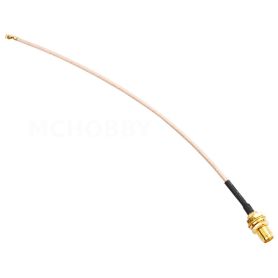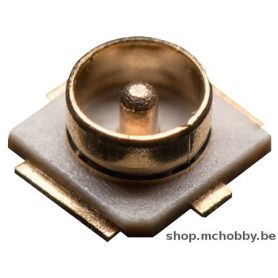RFM69HCW Transceiver Radio Breakout - 433 MHz - RadioFruit
- RFM69HCW at 433Mhz
- SX1231 based module with SPI interface
- 50mA to 150mA
- ~30mA during active radio listening.
- Packet radio with ready-to-go Arduino libraries
- Uses the amateur or license-free ISM band (ITU "Europe" license-free ISM)
- Use a simple wire antenna or spot for uFL or SMA radio connector
- 500m to 2Km, even 5 (depending on the Antenna)
Payments are secured by LyraCollect, a French payment collection company.
It is possible to delivered to your home, to a pick-up point or picked up by appointment at MCHobby
We prepare, pack and ship your orders with great respect and care.
Feather M0 + Radio module to create telemetric measurement network from 868 MHz RFM69HCW radio module
It's magic to transport data over a long distance thank to the the easy to use the RadioFruit. It is even better, a microcontroler is already coupled to the radio module in order to create a ready to use measurement plateform.
This product includes a Feather M0 (like the Arduino Zero) and a RFM69HCW module at the 868 MHz frequency! The radio modulate the packet radio with FSK +20dBm and include some extras like encryption, auto-retransmit. With a single wire antenna, the radio module can already transmit up to 350 metres (in clear vue area). With a proper directional antenna and parameter tweaking, the distance can be greatly increased.
Feather is the new form factor standard for embeded project designed by Adafruit. Feather boards are light, thin and designed to incorporate microcontroler's base project enverywhere. The Feather family inludes lot of microcontroler cores, lots of communication technologies and lot of extensions. Don't hesitate to check our Feather category on the shop.
This version of the board includes a RFM69 868 MHz based radio module. You can use for radio transmission (the exact frequency and encryption keys are determined when the software is loaded). Notice that the product also exists in the 433 MHz with the same version of radio chipset!
The microcontroler propelling this board is a ATSAMD21G18 ARM Cortex M0 (M0 for short) running 48 MHz with a 3.3V logic. The M0 is exactly the same microcontroler than Arduino Zero. This microcontroler embed 256 KiB of FLASH (8x Atmega328 or 32u4) and 32KiB of RAM (16x as much)!
As the M0 includes a native support for USB, there is no need for additional FTDI chip to program and debug your projets.
Like any other Feather plateform, this board includes a connector to plug 3.7V Lithium polymer batteries and also have the charging circuitery to recharge the LiPo when the Feather is plugged onto an USB source. The Feather will automatically switch over to USB or LiPo power when its available (the LiPo is not necessary to make this board running proprely).
About radio transmission
The packet radios transmissions are more simple than WiFi or Bluetooth Low Energy (BLE). No need to scan for networks or to make pairing (as with Bluetooth) or configure the WiFi parameters. Thank to packet Radio, we can emit data over the air without worry about the pairing and WiFi connexion. All the other module listening on the same frequency (and having the proper encryption key) can receive the messages. Then, the receiver can send a response.
The board is populated with a specialized radio breakout circuitery taking care of the packet radio transmission,'auto-retransmit and data correction.
This breakout work great with microcontrolers (like Arduino) fitted on the board. The board can be used to collect the data in the neighborhood or in the town. The constraint with those radio board is that you need at least 2 identical radio breakout (emitter and receiver, you can also use more than 2 board) using the same frequency.
The packet radio modules does exists in 4 flavours:
- 2 kinds of modulation: RFM69 & LoRa
- 2 frequency range: 433 Mhz & 868-900 Mhz
The RFM69 modules are easy to use. RFM69 is well known and easy to use (LoRa boards are more powerful but also more expensive).
Technical details
- Size: 51mm x 23mm x 8mm (without headers)
- Weight: 5.8 grams
- ATSAMD21G18 @ 48MHz with 3.3V logic/power
- No EEPROM
- 3.3V regulator with 500mA peak current outpout
- USB native support, comes with USB bootloader and serial port debugging
- 20 GPIO pins
- 8 x PWM pins
- 10 x analog inputs
- 1 x analog output
- Hardware Serial, hardware I2C, hardware SPI support
- Built in 100mA lipoly charger with charging status indicator LED
- Pin #13 red LED for general purpose blinking
- Power/enable pin
- 4 mounting holes
- Reset button
- RFM69HCW datasheet (SX1231 datasheet)
The Feather M0 Radio uses the extra space of the board to include the RFM69HCW 868MHz radio module. These radios work very well to transmit small data packet but are not good for transmitting audio or video content. They will be a nice alternative when you need more range than 2.4 GHz (BT, BLE, WiFi, ZigBee)
- RadioFruit breakout based on the SX1231 module (SPI interface)
- +13 dBm to +20 dBm (up tp 100 mW power output, power is configured in the software)
- Current while transmitting: 50mA @ +13 dBm, 150mA @ +20dBm
- Current while listening: ~30mA (active listening)
- Approx. distance 350 meters. Distance depends on obfuscation, frequency, antenna and output power.
- Allow the creation of multi-point network with individual addresses for the nodes
- Encryption: paquet are encrypted with AES128
- Bibliothèque Arduino prêt à l'emploi
- Antenne: utiliser un simple fil. Emplacement permettant de souder un connecteur radio µFL.
Use the free ISM band -or- radio amateur band (ITU "Europe" license-free ISM)
Content
Comes fully assembled and tested, with a USB bootloader that lets you quickly use it with the Arduino IDE. Also include some headers that can be soldered on the board to plug it onto a breadboard.
An antenna is required to make this product working properly. The antenna can be a small piece of wire soldered in the antenna hole or solder a µFl connector or SMA connector to connect an antenna in the state of art!
Tutorials
- Adafruit Feather M0 Radio with RFM69 Packet Radio (Adafruit, English)
Take a fast and nimble Cortex M0+ processor and give it radio skillz - MicroPython for SAMD21 (Adafruit, English)
How to use MicroPython with boards like the Feather M0 & Arduino Zero! - Remote Effects Trigger Box (Adafruit, English)
Build this powerful RF Feather-based controller to wirelessly trigger props, lights, effects, and more! - 3D Printed Case for Adafruit Feather (Adafruit, English)
A Multipurpose Enclosure for Adafruit Feather - And many other tutorials available from the Adafruit product sheet.
- Utiliser les modules transciever RadioFruit pour la communication donnée sur une longue distance (Adafruit, Anglais)
Adafruit packet radio RFM69HCW et Lora RFM9X LoRa
legal documents
- DoC : Document of Conformity (pdf)
- FCC Test Report (pdf)







